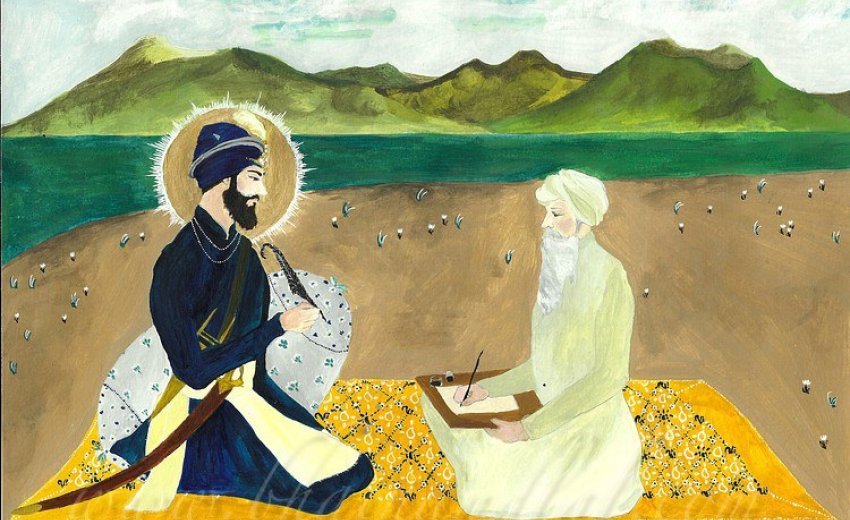Bhai Nand Lal, through his various works, shares deep insights into the Sikh faith. His writings unveil a profound understanding of its mystical aspects. One of his notable works, the rehitnama, delves into the threefold essence of Guru Gobind Singh's being. According to Bhai Nand Lal, this revelation came directly from the Guru himself during a personal encounter with the poet. In the rehitnama, the essence of Guru Gobind Singh's being is intricately described, offering readers a glimpse into the spiritual depth of Sikhism.
In the late 1680s, Guru Gobind Rai began gathering scholars in Paonta and Anandpur. Traditionally, it's said there were 52 scholar-poets, but recent research suggests there were over a hundred scholars, poets, and scribes who settled in the Guru's courts over time. They worked on scholarly treaties, spiritual texts, poetry, and more. One notable figure among them was Bhai Nand Lal Goya, who hailed from Afghanistan. In late 1695, four years before the Khalsa order's establishment, Bhai Nand Lal and Guru Gobind Rai sat by the Satluj river in Anandpur. During this meeting, the Guru dictated a rehitnama while Bhai Nand Lal respectfully listened. At the conversation's conclusion, Bhai Nand Lal named the document "Prashan Uttar" (Question and Answers).
Prashan Uttar Rehitnama
Bhai Nand Lal's rehitnama consists of two main sections. The first part outlines the daily code of conduct for Sikhs, while the second, larger part delves into philosophical discussions about the Guru's nature. According to the rehit, Sikhs are instructed to have daily darshan of the Guru. When Bhai Nand Lal questions how this is possible, the Guru reveals his threefold nature: the Nirgun, Sargun, and Gurshabad (the invisible, the visible, and the devout Sikh). These aspects of the Guru are further explored in Bhai Nand Lal's later Persian works like the Ganjnâma and Joti Bigâs.
Nirgun (The Invisible)
The Rehitnama describes the Guru's first form as mystical. The Guru represents a Light beyond creation, present in every heart and cell. Sikh philosophy aims for realization and connection with this Light, beyond human language. According to the Gurus, understanding the Guru intellectually is impossible; it's a mystical experience. Guru Nanak compares describing this experience to eating steel - very difficult. Gurbani further explains this divine understanding, different from a personal God. Guru Arjan emphasizes the Guru and the Transcendent as one, present everywhere. The Divine isn't external to please but to merge with spiritually. So, the Guru's first nature is a pervasive Light in creation.
Sargun (the Granth)
The second form of the Guru is the Granth. Bhai Nand Lal expands on this concept, emphasizing a deep connection between the Guru and the Granth. Guru Gobind Singh, in the rehitnama, urges followers to engage with the Granth, saying those who wish to communicate with him should read and reflect on its teachings. He emphasizes acknowledging the Granth as his tangible presence, rejecting any notion that it is separate from him.
These sentiments echo Guru Har Krishan's words in the Suraj Parkash, where he declares the Granth as the supreme guide. He encourages people to seek him through the Granth, promising freedom from sins and fulfillment of life's goals by following its teachings. Guru's essence resides within the Granth, urging devotees to bow daily, conquer passions, and attain liberation through its wisdom.
In understanding Sikh beliefs, it's crucial to recognize the intimate bond between Sikhs and the Guru, which is fostered through the sacred Words found in the Granth. This relationship serves as a conduit to connect with the timeless wisdom of the Satguru. In the Persian Jot Bigâs, there's a profound acknowledgment of the unity among Gurus, where Guru Gobind Singh and Guru Nanak are celebrated as one. Their teachings, likened to pearls and diamonds, illuminate the path with truth and wisdom, shining brightly with divine essence. Their words, adorned with the brilliance of truth, are treasured like precious jewels, embodying the essence of eternal wisdom and guidance for Sikhs.
Gurshabad (the devout Sikh)
The third form of the Guru is the devout Sikh who 'day and night is immersed in the Sacred Words (Gurbani)'. In Sikh teachings, the Guru emphasizes the idea of mystical union where the Sikh fully immerses themselves in the Words, becoming a living embodiment of the Guru. This concept extends to the Sikh community, known as the sangat, which is seen as a collective manifestation of the Guru's presence. Scholars like Bhai Nand Lal and Bhai Gurdas further elaborate on this notion, emphasizing the profound connection between the Sikh and the Guru.
Bhai Nand Lal, for instance, goes beyond viewing the sangat as a mere congregation involved in spiritual activities. He sees them as the physical embodiment of the Guru's teachings. In his extensive Persian work Zindaginamâ, he dedicates numerous paragraphs to extolling the virtues of the sangat, referring to them as the true Men of Truth and the people of God. According to him, the sangat comprises individuals of exceptional moral character, dedicated to spiritual practices, transcending worldly desires, and contributing to literature and oratory that inspire others toward the path of truth.
The Guru of Bhai Nand Lal
Who is Bhai Nand Lal's Guru? Unlike common perceptions among Sikhs today, Bhai Nand Lal's writings diverge from conventional notions. His Guru isn't a messenger prophesying future events or a flawless human to emulate, nor is he a saintly guide or earthly monarch. To Bhai Nand Lal, the Guru embodies Light, infusing every atom of the universe, with historical Gurus representing just a few of these manifestations. Thus, for Bhai Nand Lal, the ultimate goal is to blend with the Guru's Word and unite with this illuminating essence. This perspective sheds light on why Bhai Nand Lal extols the nature of the Gurus rather than chronicling their history, emphasizing the unity of God and creation above all else.
Bhai Nand Lal in later Sikh tradition
According to Bhai Nand Lal's writings, the Guru exists in three forms: the invisible, the visible, and the devout Sikhs, forming a trinity. This concept is detailed in Gurbani and Bhai Gurdas' works. Bhai Nand Lal's writings showcase his profound understanding of Sikh philosophy. Written in classical Persian, they encourage us to reconsider our understanding of the Sikh religion regularly.
After Bhai Nand Lal passed away in 1712, people continued to honor and respect him for many generations. In 1775, the renowned Sikh historian Saroop Das Bhalla beautifully captured the prevailing spirit and tradition in his Mahima Prakash. He admired Bhai Nand Lal's subtle personality, mystical tendencies, and wisdom. Saroop Das Bhalla wrote about how, like the Philosopher's stone turning iron into gold, meeting a compassionate true guru fills a devotee with joy and contentment. In that moment, divine light illuminates the heart, freeing it from doubt and leading to deep meditation, awakening from worldly slumber. Bhai Nand Lal exemplified such devotion, echoing Guru Nanak's words about the blessings bestowed by the grace of the Lord upon devotees.
The Rehitnama Prashan Uttar is a concise but profound document that deserves recognition among mainstream Sikhs. We urge readers to explore and delve into its contents to grasp a richer comprehension of the Guru's essence. Familiarizing oneself with this document can offer profound insights into Sikh principles and practices. It is essential for Sikhs to embrace and study this document to deepen their connection with the teachings of the Guru.
*Based on an article published in The Sikhnugget by 30th August 2012

